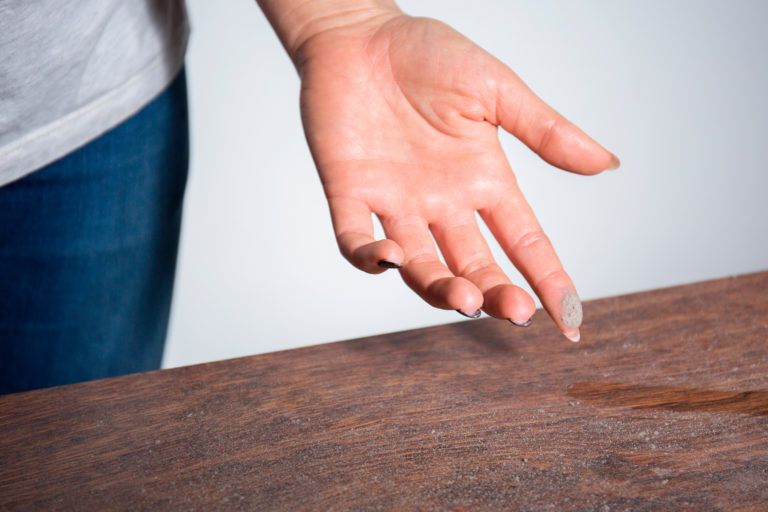
Quick Tips
They say dust is mostly dead skin. They also say you should drink eight glasses of water a day, floss twice, and call your mother more often. But look at you. Your shelves? Caked in filth. Your ceiling fan? A fur-covered biohazard rotating in slow motion. That dresser you haven’t moved since 2017? Lifting it would reveal an archaeological site of debris, dust bunnies hardened into fossils. This isn’t just dirt. It’s time. It’s your time, breaking down, molecule by molecule, settling in places you don’t look at until company’s coming over. And by then, it’s too late.
How to Clean Dust: 6 Steps to Fighting the Endless War
1. Accept That You Will Never Win
Dust isn’t a problem you solve. It’s a battle you delay. The minute you wipe it away, it’s already coming back. Floating through the air, invisible, biding its time until it settles again. According to the American Lung Association, household dust carries pollen, mold spores, dead insects, bits of plastic, and all the microscopic horrors that exist in your home’s atmosphere. You breathe this. You live with it. And no matter how hard you fight, you can’t make it stop. But you can make it suffer.
2. Start at the Top, Because Gravity Is a Jerk
You dust from the bottom up? Congratulations, you’ve just ensured all your work is pointless. Dust falls. It settles. It finds its way down no matter what you do. Start with ceiling fans, light fixtures, the tops of shelves—the places you never look at until one day you do, and it ruins your entire sense of self-worth. A microfiber cloth works, trapping dust instead of just launching it into the air like a doomed confetti parade. The National Cleaning Institute warns that using a dry rag just pushes dust around, spreading your shame evenly across every surface. Use a damp cloth or electrostatic duster to lock it down.
3. The Airborne Threat: Stop Dust Before It Lands
You know what’s worse than wiping dust? Watching it float back onto the surface you just cleaned. This is because your HVAC system, your ceiling fans, your own breath, keep it circulating like an unstoppable cosmic joke. The Environmental Protection Agency suggests using HEPA filters in your air vents to catch the microscopic filth before it settles. If you think you’re above changing your air filter, go take a look at it now. If it’s the color of disappointment and failure, congratulations—you’re part of the problem.
4. The Soft Surfaces Are the Worst Ones
Think you’re done because you wiped down the shelves? Look down. That couch? Full of dust. Your curtains? They’ve absorbed so much airborne filth they could legally qualify as insulation. Rugs, upholstery, pillows—dust’s favorite hiding places. According to the Asthma and Allergy Foundation of America, soft fabrics hold onto allergens longer than hard surfaces, turning your living room into a slow-motion biohazard. Vacuum with a HEPA filter. Wash your curtains before they gain sentience. Shake out throw blankets like you’re exorcising something.
5. The Vents, the Ducts, the Unseen Horror
You want to know where all that dust goes? Inside the vents. You don’t see it, which means you don’t think about it, and that’s exactly how it wins. Every time your heat or AC kicks on, it blows microscopic filth back into your lungs, your furniture, your soul. The National Air Duct Cleaners Association suggests getting ducts professionally cleaned every three to five years, or whenever you start wondering why your house constantly smells like an old book left in a damp basement. Meanwhile, you can remove vent covers, vacuum inside, and maybe try not to cry at what’s been lurking in there.
6. Accept That This Is Your Life Now
Dust is patient. It waits for you to get lazy. It thrives in neglect. It is always falling, settling, rebuilding itself into new layers of failure. You can fight it, but it will always return. The best you can do is keep moving. Dust regularly, change your air filters, vacuum like your dignity depends on it. Because one day, you’ll catch a ray of sunlight streaming through the window, illuminating a swirling galaxy of floating debris, and you’ll know the truth. You were never in control.
How Professionals Clean Dust
At some point, you may consider outsourcing this existential nightmare. Professional cleaners don’t just wipe things down—they deep clean, exorcising the filth from every surface. The International Sanitary Supply Association recommends industrial-grade HEPA vacuums, microfiber technology, and high-efficiency air purifiers to remove dust before it becomes part of your home’s personality. If your vents are clogged, your carpet is a graveyard of dead skin cells, or your air feels like a fine powder is always present—it’s time to call in the pros.
Final Thoughts
So you’ve cleaned the dust. For now. The shelves are clear, the air feels lighter, and for a brief moment, you believe you’ve won. But you know better. Dust never stops. It falls, it settles, it waits. It’s in your hair, in your lungs, in the very fabric of your existence. And just like that, you’re back where you started—watching, waiting, knowing that the dust always returns.